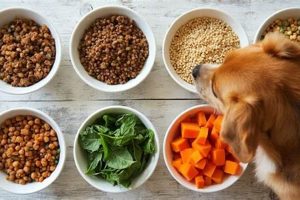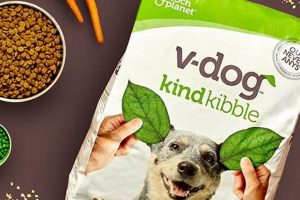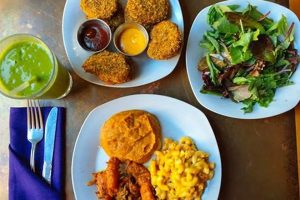Plant-based eating in Germany has experienced substantial growth, reflecting a broader global shift toward veganism. This culinary landscape encompasses a wide array of dishes and products, ranging from traditional German meals reimagined without animal products to innovative, entirely new creations. Availability extends from specialized vegan restaurants and cafes to mainstream supermarkets, demonstrating increasing accessibility for those adhering to or exploring a vegan diet.
The rise of meat-free and dairy-free options in Germany is driven by multiple factors, including growing awareness of environmental sustainability, animal welfare concerns, and potential health benefits. Historically, German cuisine relied heavily on meat and dairy; however, evolving consumer preferences and increased demand for ethical and sustainable food choices have fueled the expansion of the vegan market. This shift has created opportunities for both established food companies and emerging vegan startups.
The following sections will delve into specific examples of this cuisine, the availability of ingredients and dining establishments, and the ongoing evolution of the plant-based food sector within the country.
Successfully embracing plant-based options in Germany requires awareness of local resources and common practices. This section offers practical guidance for sourcing ingredients and enjoying vegan meals.
Tip 1: Understand Labeling. Product labels in Germany clearly indicate ingredients. Look for certifications like the V-Label (vegan or vegetarian) to ensure compliance with specific dietary restrictions.
Tip 2: Explore Reformhuser. Reformhuser (health food stores) offer a wide selection of specialized vegan products, including plant-based alternatives and nutritional supplements. These stores often carry brands not commonly found in mainstream supermarkets.
Tip 3: Utilize Weekly Markets. Weekly markets (Wochenmrkte) provide access to fresh, locally-sourced produce. Engaging with vendors allows for direct inquiry regarding farming practices and product ingredients.
Tip 4: Be Aware of Hidden Animal Products. Certain traditional German dishes may contain unexpected animal products. For example, some types of bread (Brot) use animal-derived fats. Inquire about ingredients when dining out.
Tip 5: Leverage Online Resources. Numerous websites and apps provide information on vegan restaurants, supermarkets, and product availability throughout Germany. These resources can facilitate meal planning and grocery shopping.
Tip 6: Learn Key Phrases. Knowing a few basic German phrases related to dietary needs (“Ich bin Veganer/in” – I am vegan) can assist in communicating requirements to restaurant staff and shopkeepers.
By implementing these tips, individuals can effectively navigate the German food landscape and readily access plant-based choices. A proactive approach, combined with awareness of local resources, ensures a fulfilling and accessible experience.
The subsequent section presents a selection of vegan dishes commonly found throughout Germany, highlighting both traditional adaptations and innovative creations.
1. Accessibility Increase
The increasing accessibility of plant-based options is a central element of the burgeoning market for “germany vegan food.” This facet highlights the growing ease with which individuals can find and incorporate vegan choices into their daily diets within Germany.
- Supermarket Expansion
Mainstream supermarkets across Germany have significantly expanded their vegan product offerings. Where previously limited to health food stores, plant-based milks, meat substitutes, and ready-made meals are now readily available alongside conventional products. This normalization fosters increased adoption of veganism by reducing barriers to entry.
- Restaurant Availability
The proliferation of vegan and vegan-friendly restaurants demonstrates a broader acceptance of plant-based diets. From dedicated vegan establishments to traditional German restaurants offering vegan options, consumers have a greater variety of dining choices. This expands the appeal of veganism beyond niche markets.
- Online Retail Growth
Online retailers specializing in vegan products have experienced substantial growth. This allows consumers across Germany, including those in rural areas with limited access to physical stores, to readily purchase a wide range of vegan goods, from specialty ingredients to prepared foods. This broader distribution network contributes to greater accessibility.
- Price Competitiveness
As demand increases and production scales up, the price of vegan products becomes more competitive with their animal-based counterparts. This cost reduction makes plant-based eating more accessible to a wider range of consumers, removing a significant economic barrier that may have previously discouraged adoption.
These factors collectively illustrate a significant shift in the availability of plant-based choices in Germany. The increasing presence of these items in mainstream retail environments, coupled with the growth of specialized outlets and online retailers, has greatly enhanced the accessibility of “germany vegan food,” making it easier for individuals to adopt and maintain a vegan lifestyle.
2. Traditional adaptations
Traditional German cuisine, historically reliant on animal products, presents a unique challenge and opportunity for vegan adaptation. The reinvention of classic dishes to exclude meat, dairy, and eggs necessitates careful consideration of flavor profiles, textures, and cultural significance. The following facets explore the intersection of traditional German food and its vegan iterations.
- Sauerbraten Reinvented
Sauerbraten, a marinated pot roast, traditionally requires beef. Vegan adaptations often utilize seitan or smoked tofu as a base, employing a similar marinade of vinegar, spices, and vegetables to replicate the characteristic tangy flavor. The texture, however, can differ significantly, requiring careful preparation and cooking techniques to achieve a satisfactory result.
- Kartoffelsalat Variations
Potato salad, a staple of German cuisine, frequently includes mayonnaise and bacon. Vegan versions substitute plant-based mayonnaise and smoked paprika or tempeh bacon to emulate the smoky and creamy elements. The use of alternative dressings can also significantly alter the taste profile, necessitating adjustments to maintain the dish’s familiar character.
- Sptzle Innovation
Sptzle, a type of soft egg noodle, presents a challenge for vegan preparation. Recipes typically substitute egg replacers like applesauce or flaxseed meal to bind the dough. The resulting texture may be less elastic than traditional Sptzle, impacting the overall mouthfeel and requiring modifications to cooking times.
- Kuchen Transformations
German cakes (Kuchen) often rely heavily on eggs and dairy. Vegan bakers adapt these recipes using plant-based milks, oil, and fruit purees to provide moisture and structure. Adjustments to leavening agents may be necessary to compensate for the absence of eggs, and creative substitutions are required to maintain the desired flavor and consistency.
These examples underscore the complexities inherent in adapting traditional German dishes for a vegan diet. While replicating the exact taste and texture of the original is often unattainable, these culinary adaptations strive to capture the essence of German culinary heritage while aligning with plant-based ethical and dietary principles. The ongoing evolution of “germany vegan food” hinges on the continued innovation and refinement of these adaptations.
3. Innovative creations
The realm of “germany vegan food” is not solely defined by the adaptation of traditional dishes. A significant aspect of its growth lies in innovative creations, which leverage novel ingredients and techniques to produce entirely new culinary experiences. These innovations reflect a departure from established norms, showcasing the versatility and potential of plant-based cuisine within Germany.
- Jackfruit as Meat Substitute
The utilization of jackfruit as a meat substitute exemplifies innovative approaches. Unripe jackfruit possesses a fibrous texture that, when cooked, mimics pulled pork or shredded chicken. German chefs and food manufacturers are incorporating jackfruit into vegan versions of classic dishes like gyros or pulled pork sandwiches, offering a texturally satisfying alternative to traditional meat products. This innovation addresses a key challenge in vegan cuisine: replicating the mouthfeel of meat.
- Aquafaba Applications
Aquafaba, the liquid from cooked chickpeas, has emerged as a versatile ingredient in vegan baking and dessert preparation. Its protein and starch content allow it to function as an egg replacement in meringues, mousses, and other desserts. German pastry chefs are experimenting with aquafaba to create vegan versions of traditional German cakes and pastries, expanding the possibilities for plant-based desserts. This innovation reduces reliance on processed egg replacers, offering a more natural alternative.
- Fermented Plant-Based Products
Fermentation techniques are being applied to plant-based ingredients to create unique flavors and textures. German producers are experimenting with fermenting soybeans, pulses, and grains to develop vegan cheeses, yogurts, and other dairy alternatives. This process not only enhances the taste and texture of these products but also increases their nutritional value through the production of beneficial bacteria. These fermented products offer a compelling alternative to conventional dairy products.
- Molecular Gastronomy Techniques
Some innovative German chefs are employing molecular gastronomy techniques to enhance the visual and textural appeal of vegan dishes. Spherification, for example, can be used to create plant-based caviar or other visually striking elements. These techniques elevate the dining experience, demonstrating the artistic potential of “germany vegan food” and challenging preconceptions about its limitations. This experimental approach contributes to the growing acceptance and appreciation of plant-based cuisine.
These innovative creations illustrate the dynamic and evolving nature of “germany vegan food.” By embracing new ingredients, techniques, and culinary approaches, German chefs and food manufacturers are expanding the boundaries of plant-based cuisine, offering consumers a diverse and exciting range of options that cater to evolving tastes and preferences. These advancements contribute significantly to the overall growth and acceptance of veganism within Germany.
4. Ingredient availability
Ingredient availability serves as a cornerstone in the development and accessibility of plant-based food options within Germany. The direct correlation between the variety and accessibility of plant-based ingredients and the growth of “germany vegan food” is undeniable. Increased consumer demand for vegan products, coupled with evolving agricultural practices and global supply chains, has significantly impacted the domestic market.
Consider the widespread availability of soy-based products, such as tofu and tempeh. These ingredients, once relegated to specialty stores, are now staples in mainstream supermarkets, facilitating the creation of vegan versions of traditional German dishes. Similarly, the increased availability of plant-based milk alternatives, ranging from oat to almond to soy, empowers consumers to readily replace dairy in everyday cooking and baking. Specific examples include the use of jackfruit imported for meat alternatives and the cultivation of regional crops like lupin for protein alternatives. Furthermore, the accessibility of specialized ingredients like nutritional yeast and agar-agar allows for the creation of more complex and nuanced vegan dishes, expanding the culinary possibilities. This broad selection enables innovation and provides chefs and home cooks alike with the resources necessary to craft diverse and appealing plant-based meals.
Ultimately, the continued expansion of “germany vegan food” hinges on maintaining and enhancing ingredient availability. Addressing challenges in supply chains, promoting sustainable agricultural practices, and fostering local production of plant-based staples will be crucial for ensuring the long-term viability and accessibility of vegan options within Germany. The practical significance of this understanding is that continued growth in this sector creates local and international market growth for producers and retailers.
5. Market expansion
The sustained growth of the plant-based food sector within Germany is inextricably linked to the expansion of its market. This expansion encompasses various facets, each contributing to the increased visibility, accessibility, and consumer acceptance of “germany vegan food.” Understanding these components is essential for grasping the trajectory of plant-based eating in the country.
- Increased Investment in Vegan Startups
Investment firms are allocating significant capital to vegan startups operating within Germany. This influx of funding supports product development, marketing initiatives, and infrastructure expansion, thereby facilitating market penetration. Examples include investments in plant-based meat and dairy alternative producers, leading to increased production capacity and wider distribution networks. This demonstrates a growing confidence in the long-term viability of the market.
- Mainstream Retail Adoption
Major supermarket chains throughout Germany have markedly increased their shelf space dedicated to vegan products. This mainstream adoption signifies a shift from niche market to mass consumer appeal. The availability of vegan items alongside conventional products normalizes plant-based eating, encouraging both dedicated vegans and flexitarians to explore these options. The presence of private-label vegan products further solidifies this trend.
- Export Opportunities for German Vegan Brands
German vegan food manufacturers are increasingly exploring export opportunities to meet rising global demand. The reputation for quality and innovation associated with German products provides a competitive advantage in international markets. The ability to export plant-based goods expands the reach and impact of “germany vegan food” beyond domestic borders, contributing to its economic significance.
- Growth of Vegan Food Service Sector
The food service sector in Germany is responding to consumer demand by incorporating more vegan options into menus. From casual dining establishments to upscale restaurants, plant-based dishes are becoming increasingly prevalent. This expansion extends beyond vegetarian restaurants, with traditional German eateries adapting their offerings to accommodate vegan patrons. This broadens the accessibility and appeal of plant-based eating experiences.
In summary, the expansion of the market for “germany vegan food” is driven by investment, mainstream retail adoption, export opportunities, and a thriving food service sector. These interconnected elements contribute to a dynamic and evolving landscape, reflecting the growing acceptance and demand for plant-based options among German consumers. The continued success of this market depends on sustained innovation, strategic investment, and a commitment to meeting the evolving needs of a diverse consumer base.
Frequently Asked Questions About Vegan Cuisine in Germany
This section addresses common inquiries regarding the prevalence, accessibility, and characteristics of plant-based dietary options within the German culinary landscape. These answers aim to provide clarity and dispel misconceptions surrounding veganism in Germany.
Question 1: Is vegan food readily available throughout Germany, or is it concentrated in major cities?
While major metropolitan areas like Berlin and Munich offer a high concentration of vegan restaurants and specialized stores, plant-based options are becoming increasingly accessible in smaller towns and rural areas. Mainstream supermarkets across Germany stock a variety of vegan products, and many traditional restaurants offer at least one or two vegan choices on their menus. The degree of availability, however, may vary depending on the specific location.
Question 2: What are the typical ingredients used in German vegan cuisine?
Typical ingredients encompass a wide range of plant-based staples, including tofu, tempeh, seitan, legumes, vegetables, fruits, nuts, and seeds. Traditional German dishes are often adapted using these ingredients to replace meat, dairy, and eggs. Additionally, innovative vegan products like jackfruit (used as a meat substitute) and aquafaba (used as an egg replacement) are increasingly common.
Question 3: Are there regional variations in vegan food within Germany?
Yes, regional variations exist, reflecting the diverse culinary traditions of different parts of Germany. For example, vegan versions of Swabian dishes are more prevalent in Baden-Wrttemberg, while plant-based options inspired by North German cuisine are more common in Hamburg and Schleswig-Holstein. These variations often incorporate locally sourced ingredients and reflect the unique flavors of each region.
Question 4: How does the cost of vegan food in Germany compare to the cost of non-vegan food?
The cost comparison varies depending on the specific products and dining establishments. Some vegan products, particularly specialty items, may be more expensive than their non-vegan counterparts. However, staples like legumes, vegetables, and grains are generally affordable, and many vegan meals can be prepared at home for less than the cost of eating out. As demand for vegan products increases, prices are becoming more competitive.
Question 5: Are there certifications or labels that guarantee a product is vegan in Germany?
Yes, the V-Label is a widely recognized certification mark for vegan and vegetarian products in Germany. This label assures consumers that the product meets specific criteria regarding the absence of animal-derived ingredients and processing aids. Looking for certifications such as the V-Label provides a reliable way to identify truly vegan products.
Question 6: What challenges might a vegan traveler face when dining out in Germany?
While vegan options are becoming more common, communication barriers and a lack of understanding about vegan dietary restrictions can sometimes present challenges. It is advisable to learn a few basic German phrases related to veganism or to utilize translation apps to clearly communicate specific needs to restaurant staff. Pre-planning and researching vegan-friendly restaurants in advance can also mitigate potential difficulties.
This compilation of frequently asked questions aims to provide a foundational understanding of vegan cuisine in Germany. Continued research and exploration are encouraged for those seeking a more in-depth perspective.
The following section presents resources for further exploration of vegan culinary options within Germany.
Germany Vegan Food
The preceding analysis has illustrated the multifaceted nature of plant-based food within the German context. From the adaptation of traditional dishes to the innovation of entirely new culinary creations, the rise of veganism reflects a significant shift in consumer preferences and ethical considerations. Ingredient availability and market expansion further contribute to the growing prominence of this culinary movement. The discussion of common questions and misconceptions sought to provide clarity on the current state of plant-based eating within Germany.
The continued evolution of “germany vegan food” holds implications for both the food industry and broader societal values. Further research and dialogue are essential to address challenges related to sustainability, affordability, and accessibility, ensuring that plant-based options remain a viable and equitable choice for all consumers. The future trajectory of this movement will be shaped by ongoing innovation, informed consumer choices, and a commitment to ethical and sustainable food systems.







